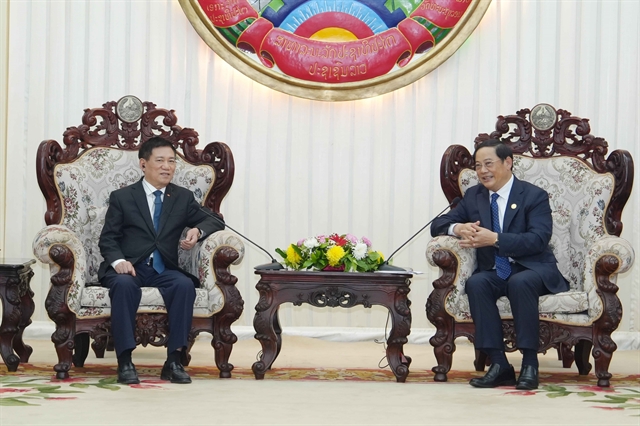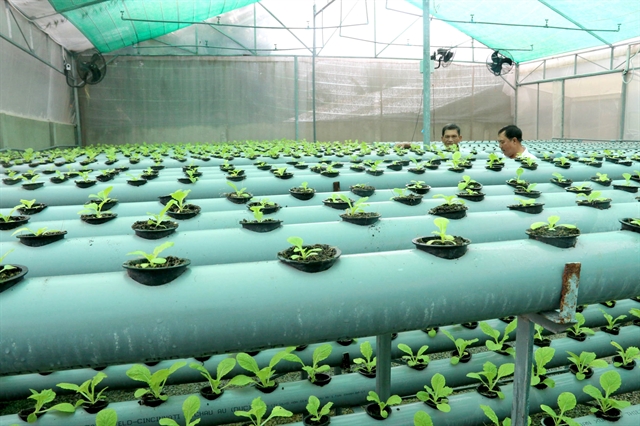 Society
Society

The use of advanced farming techniques in Tiền Giang Province’s Mỹ Tho City has improved agricultural production value as well as farmers' incomes.

|
| Growing hydroponic vegetables in net houses in Tiền Giang Province’s Mỹ Tho City. — VNA/VNS Photo Minh Trí |
TIỀN GIANG — The use of advanced farming techniques in Tiền Giang Province’s Mỹ Tho City has improved agricultural production value as well as farmers' incomes.
The Cửu Long (Mekong) Delta city has six outlying agrarian communes – Tân Mỹ Chánh, Đạo Thạnh, Trung An, Phước Thạnh, Thới Sơn and Mỹ Phong. Previously, the communes mostly grew high quality rice and farmers had unstable incomes.
To improve the quality of life, the city’s People’s Committee restructured agriculture towards urban agriculture and switched from growing rice to other high-value crops in 2010.
The city has encouraged the use of advanced farming techniques to improve the quality and yield of agricultural products as well as linkages among stakeholders to secure outlets for goods.
Dương Văn Vy switched from growing rice into growing green-skin and pink-flesh grapefruit on his 6,000sq.m field in Mỹ Phong Commune’s Mỹ Lương Hamlet in 2012.
His grapefruit orchard has 300 trees and produces 20 tonnes of grapefruit a year and offers a profit of more than VNĐ500 million (US$21,560), he said.
Mỹ Phong Commune, which has more than 300ha of green-pink and pink-flesh grapefruit, has one of the city’s major grapefruit growing areas. The fruit is in high demand locally and abroad for its delicious taste.
In Tân Mỹ Chánh Commune, authorities have identified a number of key agricultural products: flowers and ornamental plants, green-skin and pink-flesh grapefruit, xiêm đỏ coconut (a type of coconut grown for juice for drinking), red-flesh dragon fruit, cows, pigs, chicken and goats.
The development of flower and ornamental plant cultivation has helped many farmers have a stable income and become wealthy.
Đinh Ngọc Tùng, head of the city’s Economic Bureau, said the city’s outlying communes are expanding the cultivation of flowers and ornamental plants for Tết (Lunar New Year) festival.
The city has also set up co-operative groups for flowers and ornamental plant growers in Mỹ Phong and Tân Mỹ Chánh communes and clubs for growers of flowers and orchids in Mỹ Phong, Tân Mỹ Chánh and Đạo Thạnh communes.
Farmers in co-operative groups and clubs are instructed in techniques in how to grow flowers and ornamental plants according to good agricultural practices (GAP) standards.
The Mỹ Phong Commune flower and ornamental plant co-operative group has nearly 180 members, with 30 ha of flower and ornamental plants. The group supplies about 800,000 flower pots for each Tết.
Farmers who grow flowers and ornamental plants can earn a profit of VNĐ360 million ($15,500) per hectare a year.
The city sells its flowers and ornamental plants in the province and the southern region, especially in HCM City.
Advanced farming models
The city's outlying communes have expanded farming models that apply advanced techniques suited to urban agriculture.
The models include cultivation of honeydew melon, vegetables, and other short - term crops in poly greenhouses and net houses.
Châu Văn Tuấn in Tân Mỹ Chánh Commune invested VNĐ700 million ($30,250) to build two 1,000sq.m poly greenhouses for four to five crops of honeydew melon a year.
He harvests nearly 6 tonnes of honeydew melon per crop and earns a profit of dozens of millions of đồng.
He learned about the model through the province's Department of Science and Technology's Techniques and Biotechnology Centre.
Vương Thị Mỹ Thanh, deputy director of the centre, said drip irrigation systems are used and that a honeydew melon crop planted in a poly greenhouse lasts 75 days.
A 4,000 sq.m poly greenhouse can produce about 1 tonne of honeydew melon per crop, offering a profit of VNĐ11 million ($475), she said.
The province has about 80 poly greenhouses covering 500 - 1,000sq.m each for growing honeydew melon and vegetables, according to the department.
Nguyễn Thành Công, chairman of the city's People's Committee, said the expansion of advanced farming models has helped farmers in outlying areas escape poverty and have higher and sustainable incomes.
The expansion has contributed to the success of the programme of building new rural areas in the city, he said.
The city's communes have all been officially recognised as new - style rural areas.
In 2011, the city had 3,7000ha of rice fields which grew high-quality rice and had unstable incomes. All of the rice fields have been turned into areas for growing high-value crops like fruits, vegetables, flowers and ornamental plants.
The city's per capita yearly income rose from VNĐ11.52 million ($500) in 2010 to the current VNĐ53 million ($2,300).
The rate of poor households in the city is 0.99 per cent, compared to 3.6 per cent in 2011. — VNS




